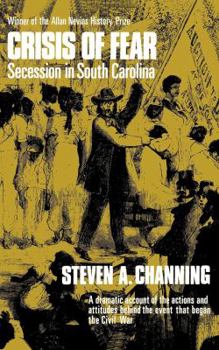Crisis of Fear: Secession in South Carolina
Select Format
Select Condition 
Book Overview
In the wake of the John Brown raid on Harpers Ferry, an atmosphere of hysteria and suspicion gripped South Carolina, an atmosphere in which large-scale slave insurrections or invasions of Northern fanatics seemed imminent. Mass arrests, feverish attempts to arm for self-defense, vigilante actions and irrational accusations became the order of the day. Far more than ideological or economic motives, it was this atmosphere, Steven Channing argues, that predisposed South Carolinians toward the great defiance that would end the Union. It provided the framework in which the radical politicians, at once exploiting the fear and dominated by it, were able to outmaneuver the Unionists and bring about secession.
Format:Paperback
Language:English
ISBN:0393007308
ISBN13:9780393007305
Release Date:May 1974
Publisher:W. W. Norton & Company
Length:316 Pages
Weight:0.66 lbs.
Dimensions:0.8" x 5.0" x 8.1"
Related Subjects
Civil War History Military Political Science Politics & Social Sciences State & LocalCustomer Reviews
1 rating
An Excellent Study of South Carolina's Secession
Published by Thriftbooks.com User , 23 years ago
Stephen Channing ascribes the secessionist movement of 1860 in South Carolina to a "crisis of fear." South Carolinians, ever conscious of the black majority in their state, worried continuously about controlling the Negro in the absence of slavery. This fear, according to Channing, was crystallized into rife paranoia in the wake of John Brown's raid on Harper's Ferry. Internal tensions, such as the perpetual contest between upcountry and lowcountry planters for primacy in state government, were eclipsed by this terrible fear. Moderates, who had opposed secession or, at the least, the secession of the Palmetto state on its own, essentially handed over the reins of leadership to the radicals--at the time, it appeared that the dire warnings long spewed forth by the Fire-eaters were becoming reality. Channing implies that Southern culture differed from that of the North to such a degree that secession was inevitable, and he contends that slavery was at the core of the mindset that animated the War Between the States.






